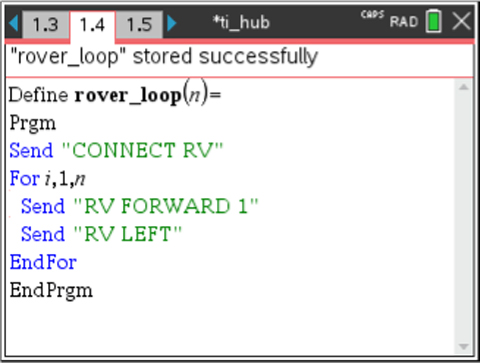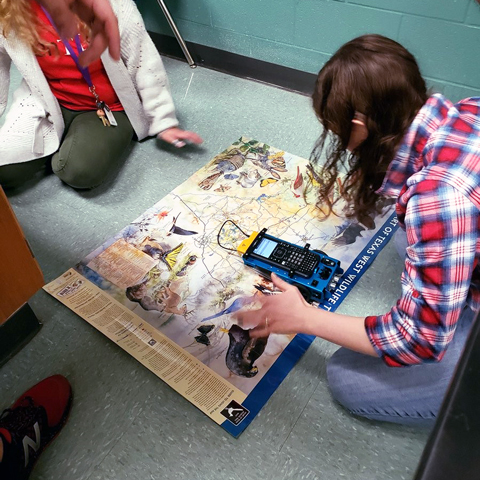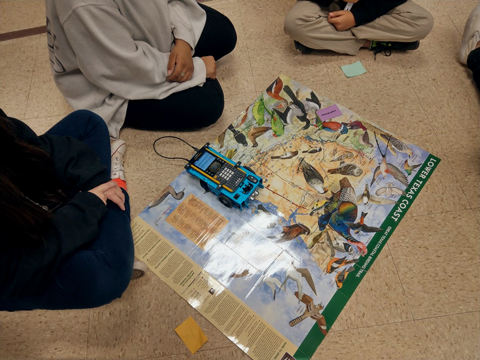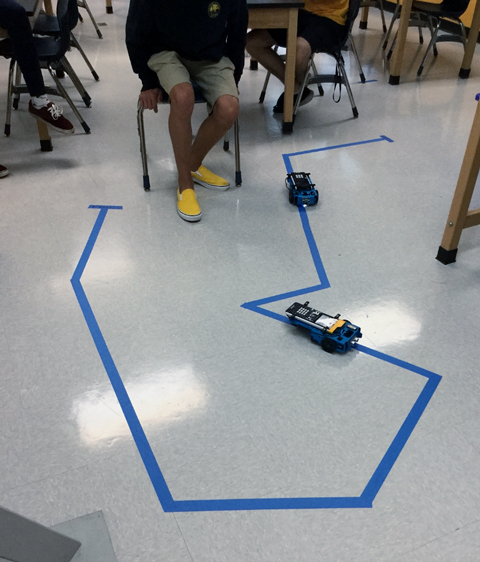Robotics — the Fourth “R” for the 21st Century
You may be aware of the reference to the three R’s, which refers to the three basic skills taught in school: reading, writing and arithmetic (usually said as “reading, writing and ’rithmetic”). How about adding another “R” to that list? Robotics! Robots (and smart machines) are all around us. In our homes (robot vacuum cleaners and smart thermostats), on the roads (cars with lane assist and smart backup cameras), in warehouses and factories, and even in hospitals and restaurants.
The one place where we don’t have enough robots is the classroom. Robots can be a very valuable addition to all classrooms. They come in many shapes, sizes, and don’t always look like you would think a “robot” would. There’s a common misconception that only robotics or a technical course will benefit from having a robot. But in my experience in talking to educators who have taken the step of including robotics-based activities in their classes, robots can enrich all classes — including history, science and math.
I have the pleasure of leading TI’s robotics outreach programs and get to work with partners to increase student participation in STEM and robotics competitions. Through this work, I am often in awe of educators’ ingenuity and creativity in the ways in which they use robots in their classrooms. My hope with this blog is to share how robots can increase understanding and engagement in your classroom. If you have questions or comments, feel free to contact me via the information at the end of the article.
Let’s take a look at seven ways educators are using robots in their classes to make learning more effective and engaging:
1. Bring math and science concepts to life. Robots are very helpful in teaching ideas in geometry and introductory algebra. The aha! moment when a student realizes why their robot is not driving a triangle even though they specified a turn of 60 degrees is priceless! This is an introduction to interior versus exterior angles that they won’t soon forget.
And solving a system of two linear equations is a lot more fun when it involves two robots driving at each other and crashing at the point of intersection. A prompt like “One robot starts at that corner” is much more impactful (pun unintended!) than “One train starts from Chicago.”
The Math in Motion set of activities are designed to use the TI-Innovator™ Rover. Students can either write their own programs in the Math in Motion Plus activities to control Rover, or students can explore math concepts using premade programs in the Math in Motion activities. Either way, students will experience math in a whole new way!
And robots can help teach science too. Students can experience topics in physics like friction and the relationship between speed, distance and time with their robots. Their understanding will be deeper as a result of observing these concepts in action. Interestingly, even topics in biology are well-suited for a robotic assistant. Science in Motion includes some of these activities that you can try in your classroom using the TI-Innovator™ Rover.
2. Show computing concepts in action. Robots are a fantastic addition to a coding-related class. The sense of accomplishment that the students have when they see their code make something move is unparalleled.
A French educator once described to me how a student was having difficulty in understanding a “for” loop until they coded a robot and used a “for” loop to control the robot’s movements. When action was put with “theory,” it made total sense to the student. More on that later.
A single pair of “forward” and “turn” commands called with different counts for the “for” loop caused the robot to move differently. A single iteration was only a forward movement, two iterations resulted in an “L,” and going to four iterations caused the robot to drive in a square.
This visual representation of a “for” loop was helpful to the student in understanding the mechanics of a “for” loop.

Seeing how changing the number of iterations changed the behavior of the robot was very helpful to the student.
Robots and their built-in sensors are also an effective way to teach conditional “if/then” statements. An effective example with real-life connections is obstacle avoidance using an ultrasonic sensor.
stop robot
else
move forward
Watching the robot act out the “if/then/else” structure is very helpful in understanding the logic.
3. Add a new dimension to a class. An ELL teacher in Lufkin ISD uses a robot to have her students create a city tour. She uses a large map on the floor, instructs her students to create an itinerary for the robot to visit the notable places in the city, and the students have to narrate the tour.
The students learn to code, program a robot, learn about a city, and get to practice their English — all within a single activity.
The same activity works for a geography or a history class too.


4. Add physical movement to the class. Studies have shown that adding physical movement to a class increases engagement and breaks up the boredom. Using robots in the classroom requires students to get up from their chairs, work as group and, possibly, go out into the hallway to test their programs. All of these help to add movement and increase student energy.
5. Cross-curricular synthesis. Robots can enable the combination of concepts in math, science and coding into a coherent activity.
Activities like programming a robot to drive through a maze require using knowledge from multiple class subjects to solve a problem. In this specific example, students used only meter sticks and protractors and wrote the code for their robots to drive a course.

6. Increased confidence. While not a direct classroom subject, students get a sense of accomplishment with robotics that increases their confidence in their own abilities to handle technology and new topics.
7. On-ramp to competitive robotics. Many schools have teams that participate in competitive robotics competitions like FIRST®, VEX Robotics or BEST.
Early introduction to coding and robotics, and exposing students to robots in the classroom, can help encourage students to participate in these type of competitions.
Ready to give robots a try? Robots are not just for robotics classes. They can enhance math, science, history and ELL and ELA classes, increase student confidence with technology, and prepare them for 21st century careers. Also, be sure to check out the recent webinar titled "Roving Around Your Math and Science Classroom" for additional ideas.
If you are interested in using Rover in your classroom, you can reach out to the TI STEM Team, or join the “TI-Innovator for Education” Google Groups™ discussion forum to discuss effective ideas with other educators. Or reach out to me on Twitter @hschhaya. Let’s make every week National Robotics Week!
About the author: Harshal S. Chhaya is a systems engineer for TI’s educational STEM products. He also leads the company’s robotics outreach programs and works with partners to increase student participation in STEM and robotics competitions. Chhaya enjoys using advanced engineering to make education fun and engaging for students and teachers. He holds 13 patents and was elected by his TI peers as a “Distinguished Member of Technical Staff (Emeritus).”
FIRST is a registered trademark of its owner. Google Groups™ is a trademark of Google LLC.
Tagcloud
Archive
- 2025
- 2024
-
2023
- January (3)
- February (3)
- March (5)
- April (3)
- May (3)
- June (3)
- July (2)
-
August (6)
- 5 Ways to Spruce Up Your Classroom for Back to School
- Day of the Dog: Which Dog Is Roundest?
- Women Who Code: A TI Intern’s Fascinating STEM Journey
- 6 Sensational TI Resources to Jump-Start Your School Year
- 3 Back-to-School Math Activities to Reenergize Your Students
- A New School Year — A New You(Tube)!
- September (2)
- October (3)
- November (1)
- 2022
-
2021
- January (2)
- February (3)
- March (5)
-
April (7)
- Top Tips for Tackling the SAT® with the TI-84 Plus CE
- Monday Night Calculus With Steve Kokoska and Tom Dick
- Which TI Calculator for the SAT® and Why?
- Top Tips From a Math Teacher for Taking the Online AP® Exam
- Celebrate National Robotics Week With Supervised Teardowns
- How To Use the TI-84 Plus Family of Graphing Calculators To Succeed on the ACT®
- AP® Statistics: 6 Math Functions You Must Know for the TI-84 Plus
- May (1)
- June (3)
- July (2)
- August (5)
- September (2)
-
October (4)
- Transformation Graphing — the Families of Functions Modular Video Series to the Rescue!
- Top 3 Halloween-Themed Classroom Activities
- In Honor of National Chemistry Week, 5 “Organic” Ways to Incorporate TI Technology Into Chemistry Class
- 5 Spook-tacular Ways to Bring the Halloween “Spirits” Into Your Classroom
- November (4)
- December (1)
-
2020
- January (2)
- February (1)
- March (3)
- April (1)
- May (2)
- July (1)
- August (2)
- September (3)
-
October (7)
- Tips for Teachers in the time of COVID-19
- Top 10 Features of TI-84 Plus for Taking the ACT®
- TI Codes Contest Winners Revealed
- Best of Chemistry Activities for the Fall Semester
- Best of Biology Activities for the Fall Semester
- Best of Physics Activities for the Fall Semester
- Best of Middle Grades Science Activities
- November (1)
- December (2)
- 2019
-
2018
- January (1)
- February (5)
- March (4)
- April (5)
- May (4)
- June (4)
- July (4)
- August (4)
- September (5)
-
October (9)
- Art in Chemistry
- Which Texas Instruments (TI) Calculator for the ACT® and Why?
- Meet TI Teacher of the Month: Jessica Kohout
- Innovation in Biology
- Learning With Your Students
- A first-of-its-kind STEM strategy charts path to help educators
- #NCTMregionals Hartford 2018 Recap
- The Math Behind “Going Viral”
- Real-World Applications of Chemistry
-
November (8)
- Testing Tips: Using Calculators on Class Assessments
- Girls in STEM: A Personal Perspective
- 5 Teachers You Should Be Following on Instagram Right Now
- Meet TI Teacher of the Month: Katie England
- End-of-Marking Period Feedback Is a Two-Way Street
- #NCTMregionals Kansas City 2018 Recap
- Slope: It Shouldn’t Just Be a Formula
- Hit a high note exploring the math behind music
- December (5)
- 2017
- 2016
- 2015
